PADM 451: Midterm Report on Improving US Healthcare System Strategies
VerifiedAdded on 2022/08/19
|14
|3392
|17
Report
AI Summary
This report analyzes the US healthcare system, focusing on strategies for improvement. The report addresses key steps for future healthcare leaders, including establishing a value base, communicating across different constituencies (hospitals, insurance companies, physicians, employers, patients), focusing on physicians, engaging and being forthright with consumers, and fostering innovation. The author emphasizes the need for patient-centered care, effective communication, physician involvement, and customer engagement. The report also discusses the US healthcare system as a market structure, highlighting the roles of various players such as the government, private corporations, and insurance companies, and the impact of market competition and resource allocation. The author suggests specific changes like implementing a single-payer system, increasing access to healthcare facilities, and promoting outcome-based quality measures. The report concludes by comparing the US healthcare system to other developed countries and examines factors contributing to its inefficiencies, such as revenue-centered approach, high costs, administrative inefficiency, and fragmented primary care. The author provides insights into how different stakeholders, including government, providers, and insurers, contribute to the current state of healthcare in the US.
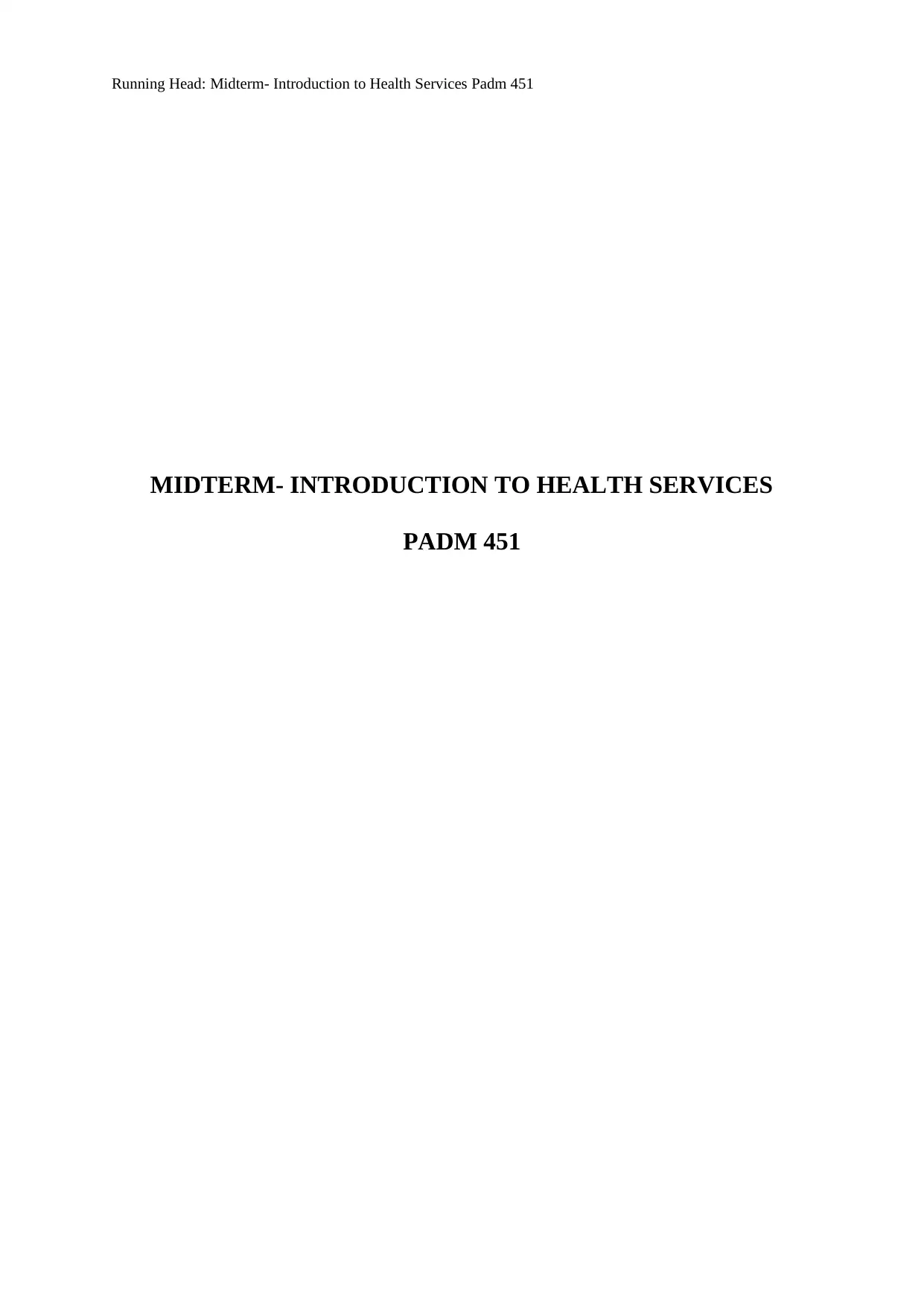
Running Head: Midterm- Introduction to Health Services Padm 451
MIDTERM- INTRODUCTION TO HEALTH SERVICES
PADM 451
MIDTERM- INTRODUCTION TO HEALTH SERVICES
PADM 451
Paraphrase This Document
Need a fresh take? Get an instant paraphrase of this document with our AI Paraphraser
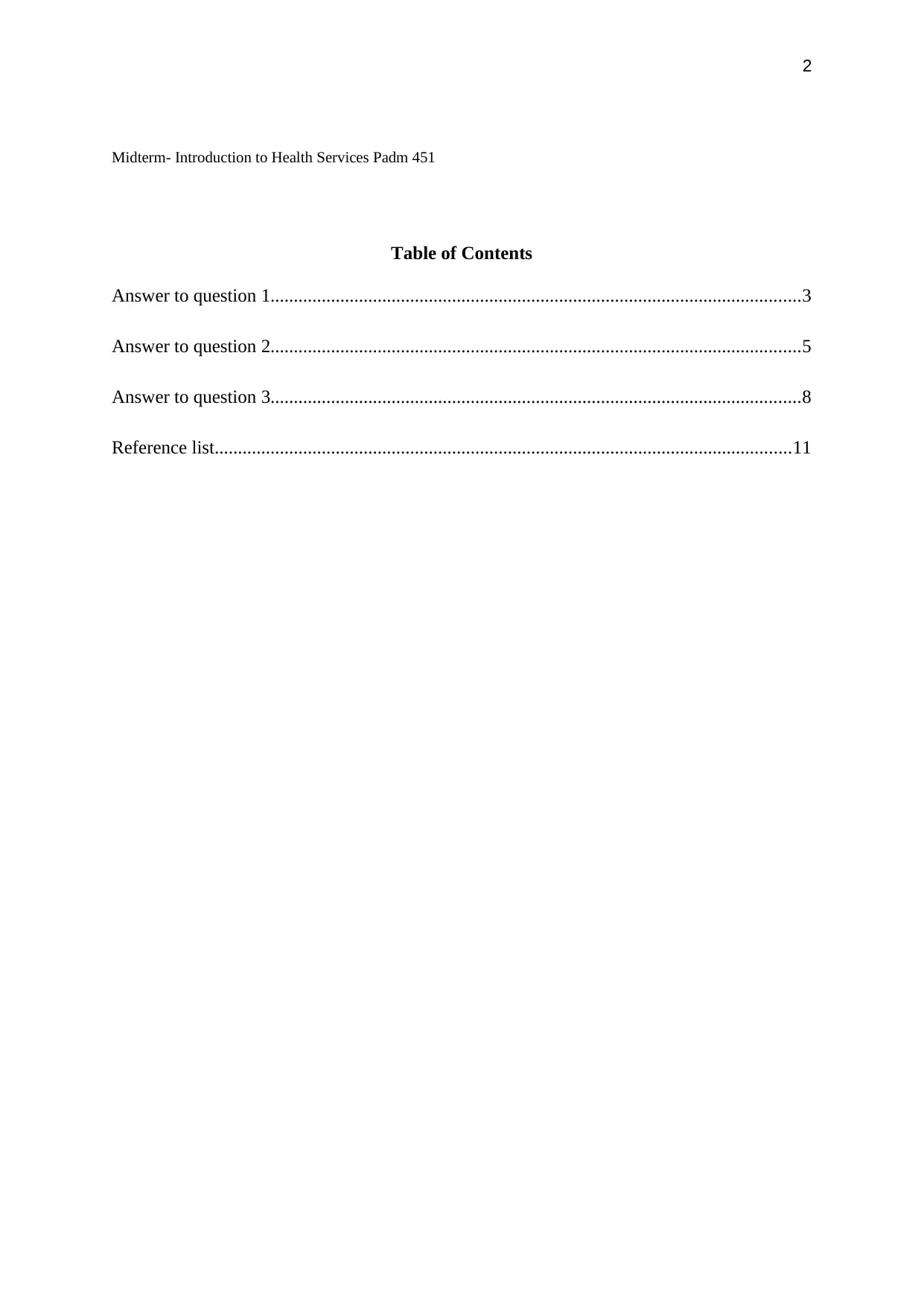
2
Midterm- Introduction to Health Services Padm 451
Table of Contents
Answer to question 1..................................................................................................................3
Answer to question 2..................................................................................................................5
Answer to question 3..................................................................................................................8
Reference list............................................................................................................................11
Midterm- Introduction to Health Services Padm 451
Table of Contents
Answer to question 1..................................................................................................................3
Answer to question 2..................................................................................................................5
Answer to question 3..................................................................................................................8
Reference list............................................................................................................................11
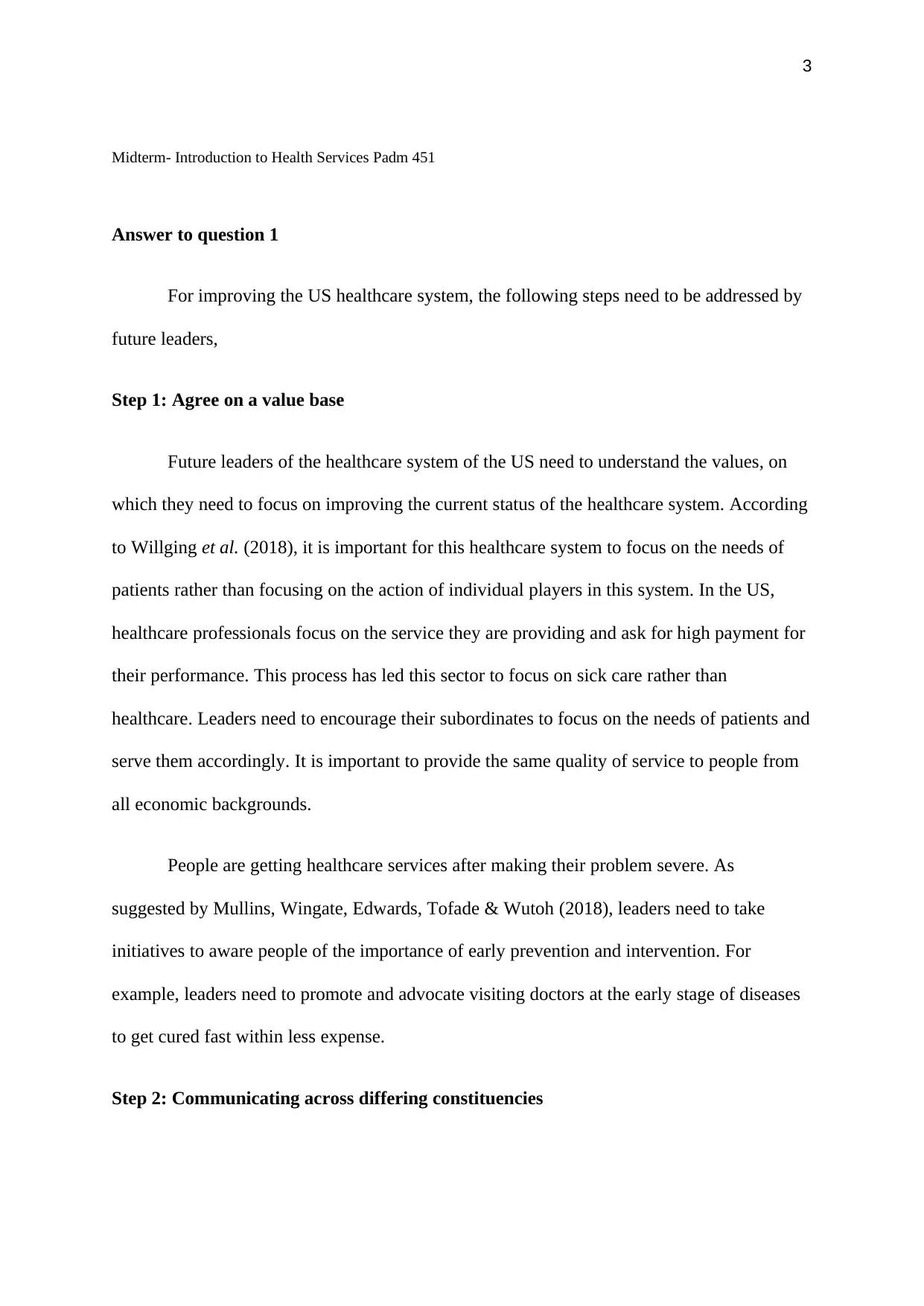
3
Midterm- Introduction to Health Services Padm 451
Answer to question 1
For improving the US healthcare system, the following steps need to be addressed by
future leaders,
Step 1: Agree on a value base
Future leaders of the healthcare system of the US need to understand the values, on
which they need to focus on improving the current status of the healthcare system. According
to Willging et al. (2018), it is important for this healthcare system to focus on the needs of
patients rather than focusing on the action of individual players in this system. In the US,
healthcare professionals focus on the service they are providing and ask for high payment for
their performance. This process has led this sector to focus on sick care rather than
healthcare. Leaders need to encourage their subordinates to focus on the needs of patients and
serve them accordingly. It is important to provide the same quality of service to people from
all economic backgrounds.
People are getting healthcare services after making their problem severe. As
suggested by Mullins, Wingate, Edwards, Tofade & Wutoh (2018), leaders need to take
initiatives to aware people of the importance of early prevention and intervention. For
example, leaders need to promote and advocate visiting doctors at the early stage of diseases
to get cured fast within less expense.
Step 2: Communicating across differing constituencies
Midterm- Introduction to Health Services Padm 451
Answer to question 1
For improving the US healthcare system, the following steps need to be addressed by
future leaders,
Step 1: Agree on a value base
Future leaders of the healthcare system of the US need to understand the values, on
which they need to focus on improving the current status of the healthcare system. According
to Willging et al. (2018), it is important for this healthcare system to focus on the needs of
patients rather than focusing on the action of individual players in this system. In the US,
healthcare professionals focus on the service they are providing and ask for high payment for
their performance. This process has led this sector to focus on sick care rather than
healthcare. Leaders need to encourage their subordinates to focus on the needs of patients and
serve them accordingly. It is important to provide the same quality of service to people from
all economic backgrounds.
People are getting healthcare services after making their problem severe. As
suggested by Mullins, Wingate, Edwards, Tofade & Wutoh (2018), leaders need to take
initiatives to aware people of the importance of early prevention and intervention. For
example, leaders need to promote and advocate visiting doctors at the early stage of diseases
to get cured fast within less expense.
Step 2: Communicating across differing constituencies
⊘ This is a preview!⊘
Do you want full access?
Subscribe today to unlock all pages.

Trusted by 1+ million students worldwide
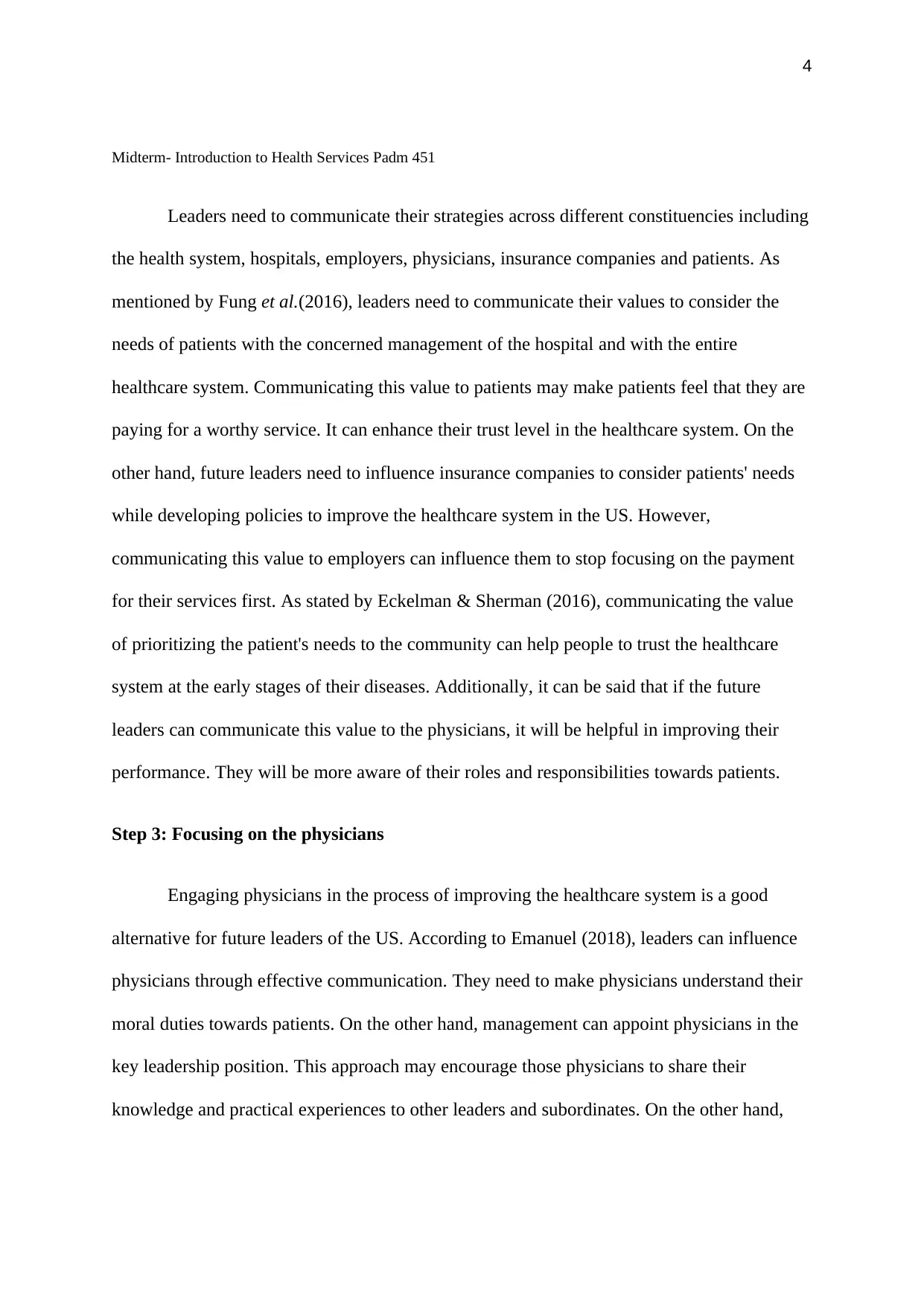
4
Midterm- Introduction to Health Services Padm 451
Leaders need to communicate their strategies across different constituencies including
the health system, hospitals, employers, physicians, insurance companies and patients. As
mentioned by Fung et al.(2016), leaders need to communicate their values to consider the
needs of patients with the concerned management of the hospital and with the entire
healthcare system. Communicating this value to patients may make patients feel that they are
paying for a worthy service. It can enhance their trust level in the healthcare system. On the
other hand, future leaders need to influence insurance companies to consider patients' needs
while developing policies to improve the healthcare system in the US. However,
communicating this value to employers can influence them to stop focusing on the payment
for their services first. As stated by Eckelman & Sherman (2016), communicating the value
of prioritizing the patient's needs to the community can help people to trust the healthcare
system at the early stages of their diseases. Additionally, it can be said that if the future
leaders can communicate this value to the physicians, it will be helpful in improving their
performance. They will be more aware of their roles and responsibilities towards patients.
Step 3: Focusing on the physicians
Engaging physicians in the process of improving the healthcare system is a good
alternative for future leaders of the US. According to Emanuel (2018), leaders can influence
physicians through effective communication. They need to make physicians understand their
moral duties towards patients. On the other hand, management can appoint physicians in the
key leadership position. This approach may encourage those physicians to share their
knowledge and practical experiences to other leaders and subordinates. On the other hand,
Midterm- Introduction to Health Services Padm 451
Leaders need to communicate their strategies across different constituencies including
the health system, hospitals, employers, physicians, insurance companies and patients. As
mentioned by Fung et al.(2016), leaders need to communicate their values to consider the
needs of patients with the concerned management of the hospital and with the entire
healthcare system. Communicating this value to patients may make patients feel that they are
paying for a worthy service. It can enhance their trust level in the healthcare system. On the
other hand, future leaders need to influence insurance companies to consider patients' needs
while developing policies to improve the healthcare system in the US. However,
communicating this value to employers can influence them to stop focusing on the payment
for their services first. As stated by Eckelman & Sherman (2016), communicating the value
of prioritizing the patient's needs to the community can help people to trust the healthcare
system at the early stages of their diseases. Additionally, it can be said that if the future
leaders can communicate this value to the physicians, it will be helpful in improving their
performance. They will be more aware of their roles and responsibilities towards patients.
Step 3: Focusing on the physicians
Engaging physicians in the process of improving the healthcare system is a good
alternative for future leaders of the US. According to Emanuel (2018), leaders can influence
physicians through effective communication. They need to make physicians understand their
moral duties towards patients. On the other hand, management can appoint physicians in the
key leadership position. This approach may encourage those physicians to share their
knowledge and practical experiences to other leaders and subordinates. On the other hand,
Paraphrase This Document
Need a fresh take? Get an instant paraphrase of this document with our AI Paraphraser
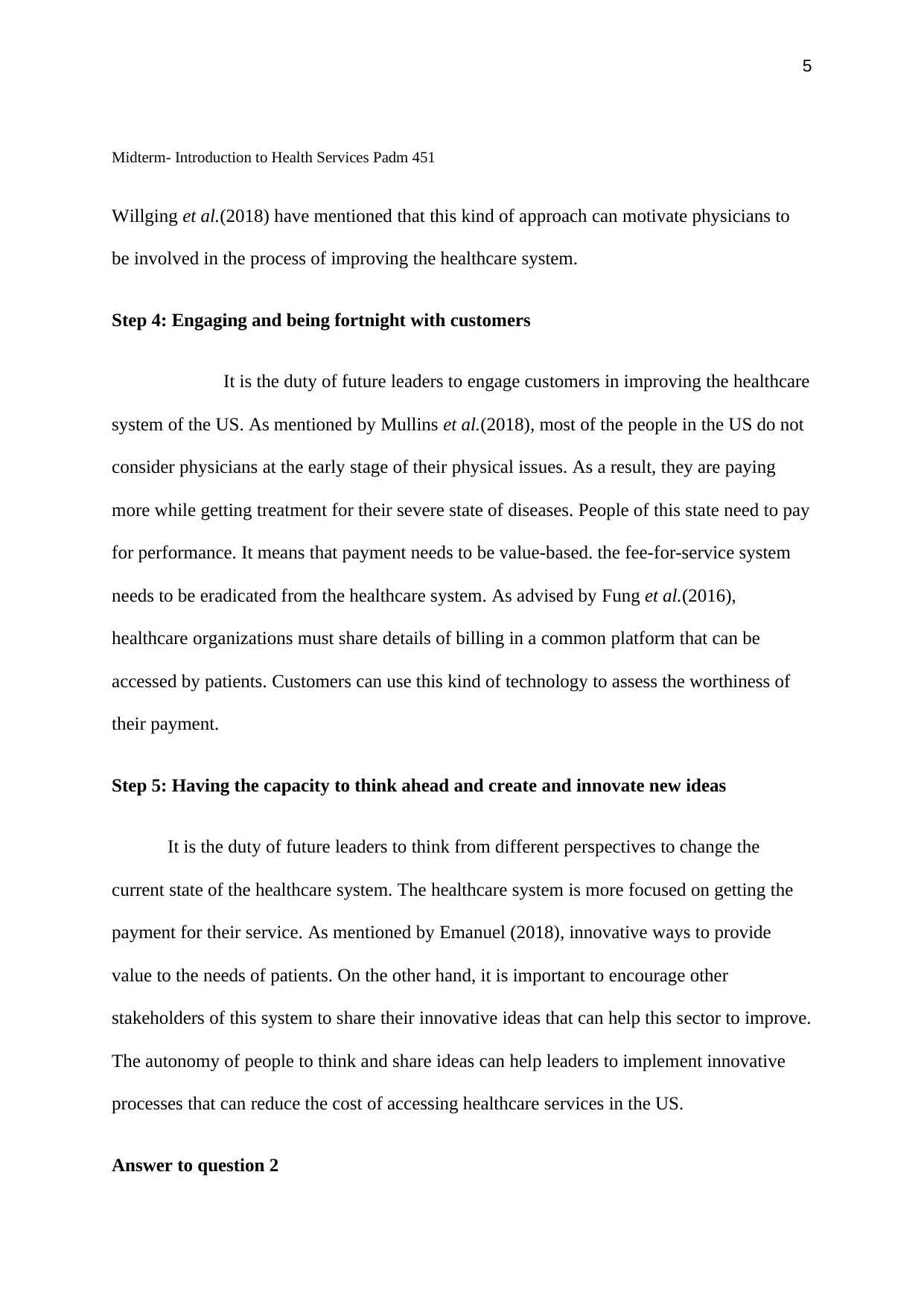
5
Midterm- Introduction to Health Services Padm 451
Willging et al.(2018) have mentioned that this kind of approach can motivate physicians to
be involved in the process of improving the healthcare system.
Step 4: Engaging and being fortnight with customers
It is the duty of future leaders to engage customers in improving the healthcare
system of the US. As mentioned by Mullins et al.(2018), most of the people in the US do not
consider physicians at the early stage of their physical issues. As a result, they are paying
more while getting treatment for their severe state of diseases. People of this state need to pay
for performance. It means that payment needs to be value-based. the fee-for-service system
needs to be eradicated from the healthcare system. As advised by Fung et al.(2016),
healthcare organizations must share details of billing in a common platform that can be
accessed by patients. Customers can use this kind of technology to assess the worthiness of
their payment.
Step 5: Having the capacity to think ahead and create and innovate new ideas
It is the duty of future leaders to think from different perspectives to change the
current state of the healthcare system. The healthcare system is more focused on getting the
payment for their service. As mentioned by Emanuel (2018), innovative ways to provide
value to the needs of patients. On the other hand, it is important to encourage other
stakeholders of this system to share their innovative ideas that can help this sector to improve.
The autonomy of people to think and share ideas can help leaders to implement innovative
processes that can reduce the cost of accessing healthcare services in the US.
Answer to question 2
Midterm- Introduction to Health Services Padm 451
Willging et al.(2018) have mentioned that this kind of approach can motivate physicians to
be involved in the process of improving the healthcare system.
Step 4: Engaging and being fortnight with customers
It is the duty of future leaders to engage customers in improving the healthcare
system of the US. As mentioned by Mullins et al.(2018), most of the people in the US do not
consider physicians at the early stage of their physical issues. As a result, they are paying
more while getting treatment for their severe state of diseases. People of this state need to pay
for performance. It means that payment needs to be value-based. the fee-for-service system
needs to be eradicated from the healthcare system. As advised by Fung et al.(2016),
healthcare organizations must share details of billing in a common platform that can be
accessed by patients. Customers can use this kind of technology to assess the worthiness of
their payment.
Step 5: Having the capacity to think ahead and create and innovate new ideas
It is the duty of future leaders to think from different perspectives to change the
current state of the healthcare system. The healthcare system is more focused on getting the
payment for their service. As mentioned by Emanuel (2018), innovative ways to provide
value to the needs of patients. On the other hand, it is important to encourage other
stakeholders of this system to share their innovative ideas that can help this sector to improve.
The autonomy of people to think and share ideas can help leaders to implement innovative
processes that can reduce the cost of accessing healthcare services in the US.
Answer to question 2
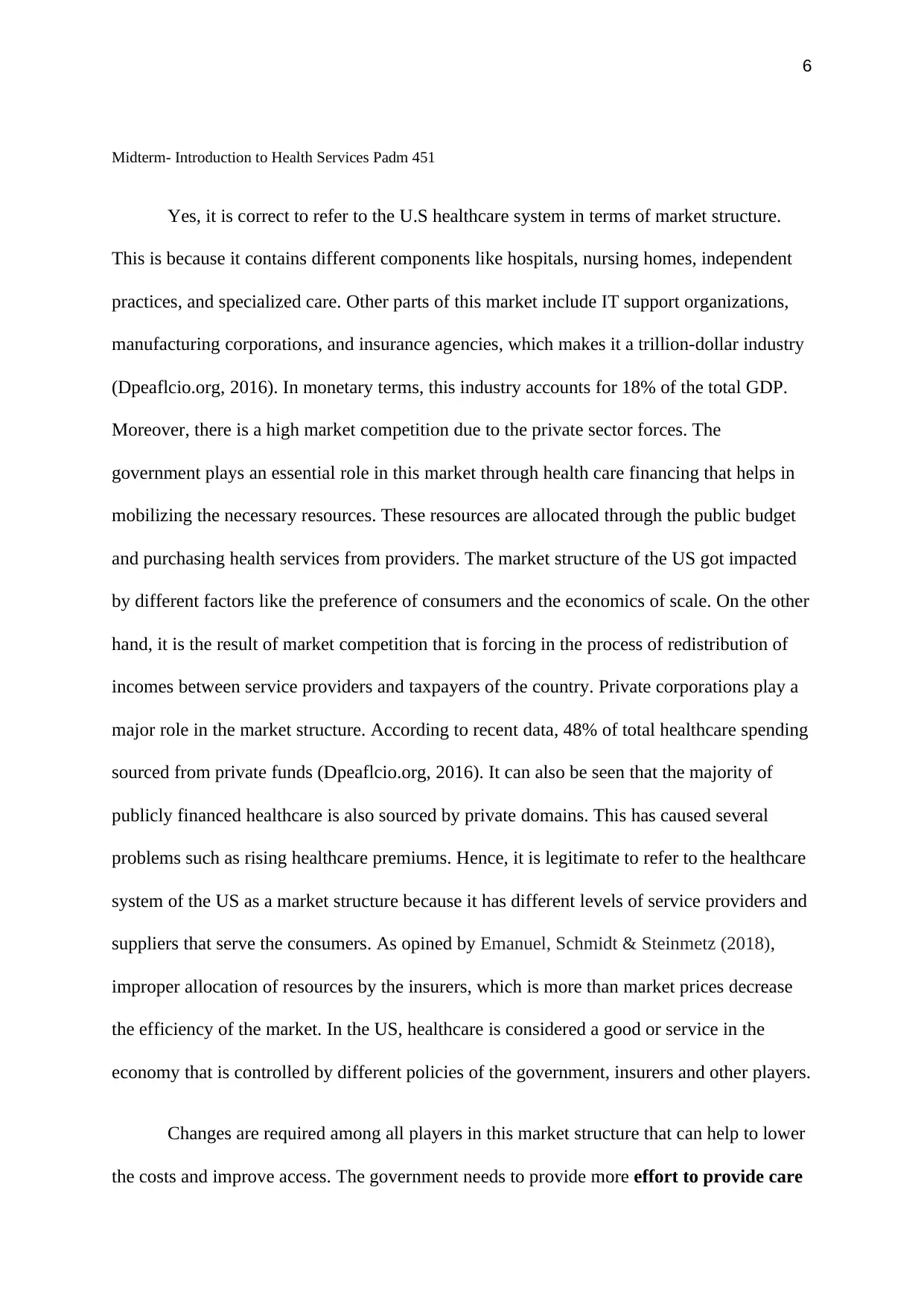
6
Midterm- Introduction to Health Services Padm 451
Yes, it is correct to refer to the U.S healthcare system in terms of market structure.
This is because it contains different components like hospitals, nursing homes, independent
practices, and specialized care. Other parts of this market include IT support organizations,
manufacturing corporations, and insurance agencies, which makes it a trillion-dollar industry
(Dpeaflcio.org, 2016). In monetary terms, this industry accounts for 18% of the total GDP.
Moreover, there is a high market competition due to the private sector forces. The
government plays an essential role in this market through health care financing that helps in
mobilizing the necessary resources. These resources are allocated through the public budget
and purchasing health services from providers. The market structure of the US got impacted
by different factors like the preference of consumers and the economics of scale. On the other
hand, it is the result of market competition that is forcing in the process of redistribution of
incomes between service providers and taxpayers of the country. Private corporations play a
major role in the market structure. According to recent data, 48% of total healthcare spending
sourced from private funds (Dpeaflcio.org, 2016). It can also be seen that the majority of
publicly financed healthcare is also sourced by private domains. This has caused several
problems such as rising healthcare premiums. Hence, it is legitimate to refer to the healthcare
system of the US as a market structure because it has different levels of service providers and
suppliers that serve the consumers. As opined by Emanuel, Schmidt & Steinmetz (2018),
improper allocation of resources by the insurers, which is more than market prices decrease
the efficiency of the market. In the US, healthcare is considered a good or service in the
economy that is controlled by different policies of the government, insurers and other players.
Changes are required among all players in this market structure that can help to lower
the costs and improve access. The government needs to provide more effort to provide care
Midterm- Introduction to Health Services Padm 451
Yes, it is correct to refer to the U.S healthcare system in terms of market structure.
This is because it contains different components like hospitals, nursing homes, independent
practices, and specialized care. Other parts of this market include IT support organizations,
manufacturing corporations, and insurance agencies, which makes it a trillion-dollar industry
(Dpeaflcio.org, 2016). In monetary terms, this industry accounts for 18% of the total GDP.
Moreover, there is a high market competition due to the private sector forces. The
government plays an essential role in this market through health care financing that helps in
mobilizing the necessary resources. These resources are allocated through the public budget
and purchasing health services from providers. The market structure of the US got impacted
by different factors like the preference of consumers and the economics of scale. On the other
hand, it is the result of market competition that is forcing in the process of redistribution of
incomes between service providers and taxpayers of the country. Private corporations play a
major role in the market structure. According to recent data, 48% of total healthcare spending
sourced from private funds (Dpeaflcio.org, 2016). It can also be seen that the majority of
publicly financed healthcare is also sourced by private domains. This has caused several
problems such as rising healthcare premiums. Hence, it is legitimate to refer to the healthcare
system of the US as a market structure because it has different levels of service providers and
suppliers that serve the consumers. As opined by Emanuel, Schmidt & Steinmetz (2018),
improper allocation of resources by the insurers, which is more than market prices decrease
the efficiency of the market. In the US, healthcare is considered a good or service in the
economy that is controlled by different policies of the government, insurers and other players.
Changes are required among all players in this market structure that can help to lower
the costs and improve access. The government needs to provide more effort to provide care
⊘ This is a preview!⊘
Do you want full access?
Subscribe today to unlock all pages.

Trusted by 1+ million students worldwide
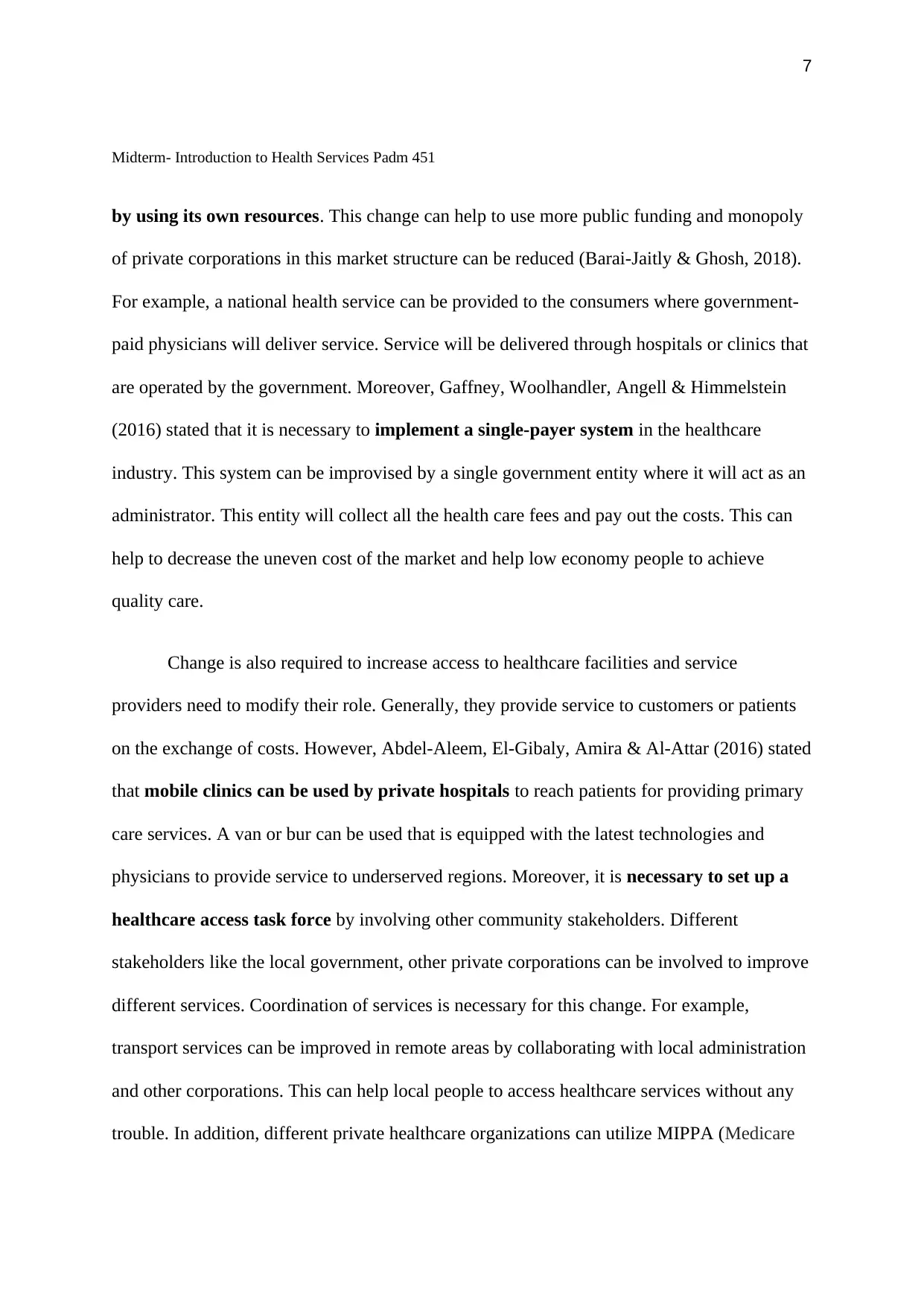
7
Midterm- Introduction to Health Services Padm 451
by using its own resources. This change can help to use more public funding and monopoly
of private corporations in this market structure can be reduced (Barai-Jaitly & Ghosh, 2018).
For example, a national health service can be provided to the consumers where government-
paid physicians will deliver service. Service will be delivered through hospitals or clinics that
are operated by the government. Moreover, Gaffney, Woolhandler, Angell & Himmelstein
(2016) stated that it is necessary to implement a single-payer system in the healthcare
industry. This system can be improvised by a single government entity where it will act as an
administrator. This entity will collect all the health care fees and pay out the costs. This can
help to decrease the uneven cost of the market and help low economy people to achieve
quality care.
Change is also required to increase access to healthcare facilities and service
providers need to modify their role. Generally, they provide service to customers or patients
on the exchange of costs. However, Abdel‐Aleem, El‐Gibaly, Amira & Al‐Attar (2016) stated
that mobile clinics can be used by private hospitals to reach patients for providing primary
care services. A van or bur can be used that is equipped with the latest technologies and
physicians to provide service to underserved regions. Moreover, it is necessary to set up a
healthcare access task force by involving other community stakeholders. Different
stakeholders like the local government, other private corporations can be involved to improve
different services. Coordination of services is necessary for this change. For example,
transport services can be improved in remote areas by collaborating with local administration
and other corporations. This can help local people to access healthcare services without any
trouble. In addition, different private healthcare organizations can utilize MIPPA (Medicare
Midterm- Introduction to Health Services Padm 451
by using its own resources. This change can help to use more public funding and monopoly
of private corporations in this market structure can be reduced (Barai-Jaitly & Ghosh, 2018).
For example, a national health service can be provided to the consumers where government-
paid physicians will deliver service. Service will be delivered through hospitals or clinics that
are operated by the government. Moreover, Gaffney, Woolhandler, Angell & Himmelstein
(2016) stated that it is necessary to implement a single-payer system in the healthcare
industry. This system can be improvised by a single government entity where it will act as an
administrator. This entity will collect all the health care fees and pay out the costs. This can
help to decrease the uneven cost of the market and help low economy people to achieve
quality care.
Change is also required to increase access to healthcare facilities and service
providers need to modify their role. Generally, they provide service to customers or patients
on the exchange of costs. However, Abdel‐Aleem, El‐Gibaly, Amira & Al‐Attar (2016) stated
that mobile clinics can be used by private hospitals to reach patients for providing primary
care services. A van or bur can be used that is equipped with the latest technologies and
physicians to provide service to underserved regions. Moreover, it is necessary to set up a
healthcare access task force by involving other community stakeholders. Different
stakeholders like the local government, other private corporations can be involved to improve
different services. Coordination of services is necessary for this change. For example,
transport services can be improved in remote areas by collaborating with local administration
and other corporations. This can help local people to access healthcare services without any
trouble. In addition, different private healthcare organizations can utilize MIPPA (Medicare
Paraphrase This Document
Need a fresh take? Get an instant paraphrase of this document with our AI Paraphraser
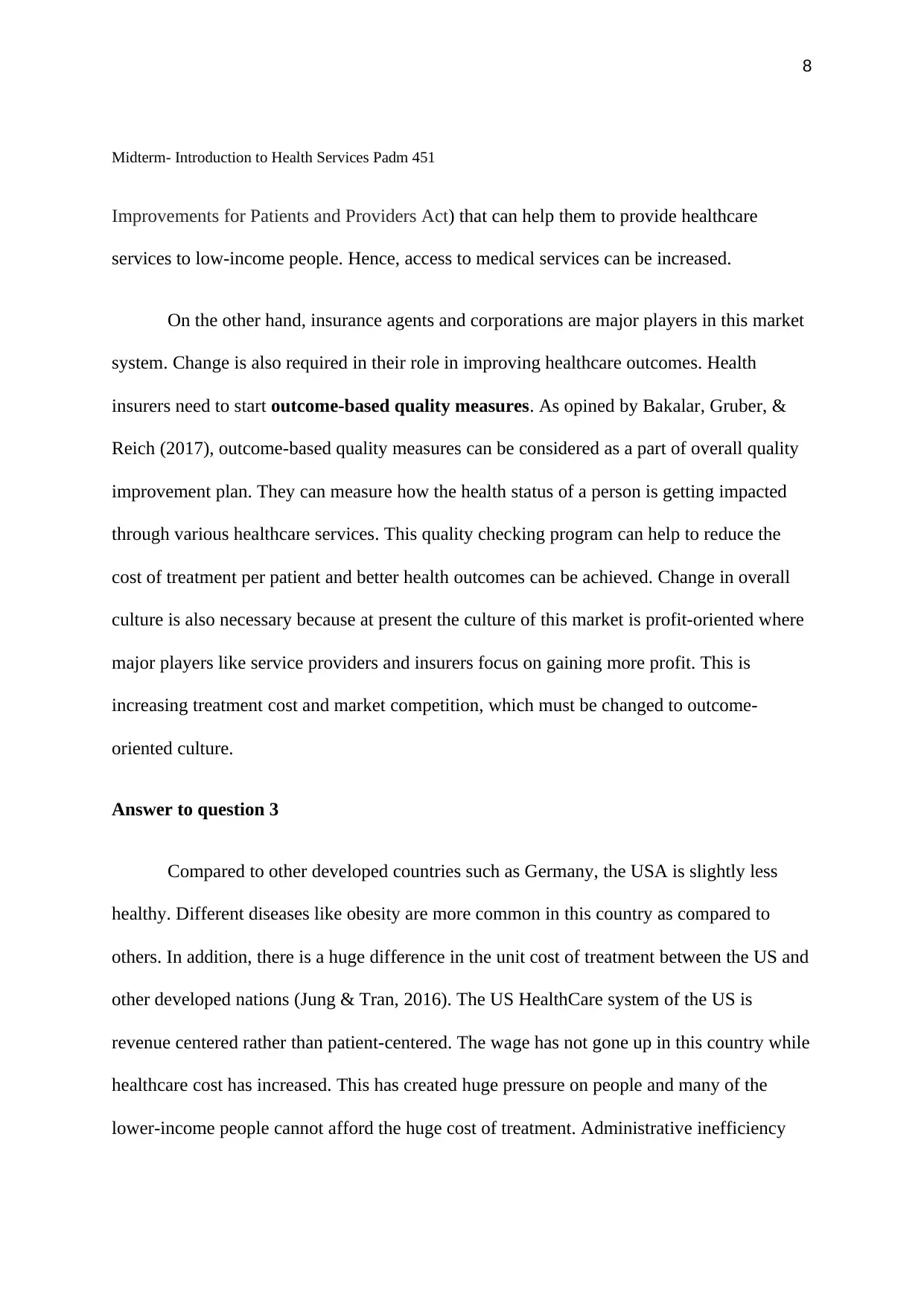
8
Midterm- Introduction to Health Services Padm 451
Improvements for Patients and Providers Act) that can help them to provide healthcare
services to low-income people. Hence, access to medical services can be increased.
On the other hand, insurance agents and corporations are major players in this market
system. Change is also required in their role in improving healthcare outcomes. Health
insurers need to start outcome-based quality measures. As opined by Bakalar, Gruber, &
Reich (2017), outcome-based quality measures can be considered as a part of overall quality
improvement plan. They can measure how the health status of a person is getting impacted
through various healthcare services. This quality checking program can help to reduce the
cost of treatment per patient and better health outcomes can be achieved. Change in overall
culture is also necessary because at present the culture of this market is profit-oriented where
major players like service providers and insurers focus on gaining more profit. This is
increasing treatment cost and market competition, which must be changed to outcome-
oriented culture.
Answer to question 3
Compared to other developed countries such as Germany, the USA is slightly less
healthy. Different diseases like obesity are more common in this country as compared to
others. In addition, there is a huge difference in the unit cost of treatment between the US and
other developed nations (Jung & Tran, 2016). The US HealthCare system of the US is
revenue centered rather than patient-centered. The wage has not gone up in this country while
healthcare cost has increased. This has created huge pressure on people and many of the
lower-income people cannot afford the huge cost of treatment. Administrative inefficiency
Midterm- Introduction to Health Services Padm 451
Improvements for Patients and Providers Act) that can help them to provide healthcare
services to low-income people. Hence, access to medical services can be increased.
On the other hand, insurance agents and corporations are major players in this market
system. Change is also required in their role in improving healthcare outcomes. Health
insurers need to start outcome-based quality measures. As opined by Bakalar, Gruber, &
Reich (2017), outcome-based quality measures can be considered as a part of overall quality
improvement plan. They can measure how the health status of a person is getting impacted
through various healthcare services. This quality checking program can help to reduce the
cost of treatment per patient and better health outcomes can be achieved. Change in overall
culture is also necessary because at present the culture of this market is profit-oriented where
major players like service providers and insurers focus on gaining more profit. This is
increasing treatment cost and market competition, which must be changed to outcome-
oriented culture.
Answer to question 3
Compared to other developed countries such as Germany, the USA is slightly less
healthy. Different diseases like obesity are more common in this country as compared to
others. In addition, there is a huge difference in the unit cost of treatment between the US and
other developed nations (Jung & Tran, 2016). The US HealthCare system of the US is
revenue centered rather than patient-centered. The wage has not gone up in this country while
healthcare cost has increased. This has created huge pressure on people and many of the
lower-income people cannot afford the huge cost of treatment. Administrative inefficiency
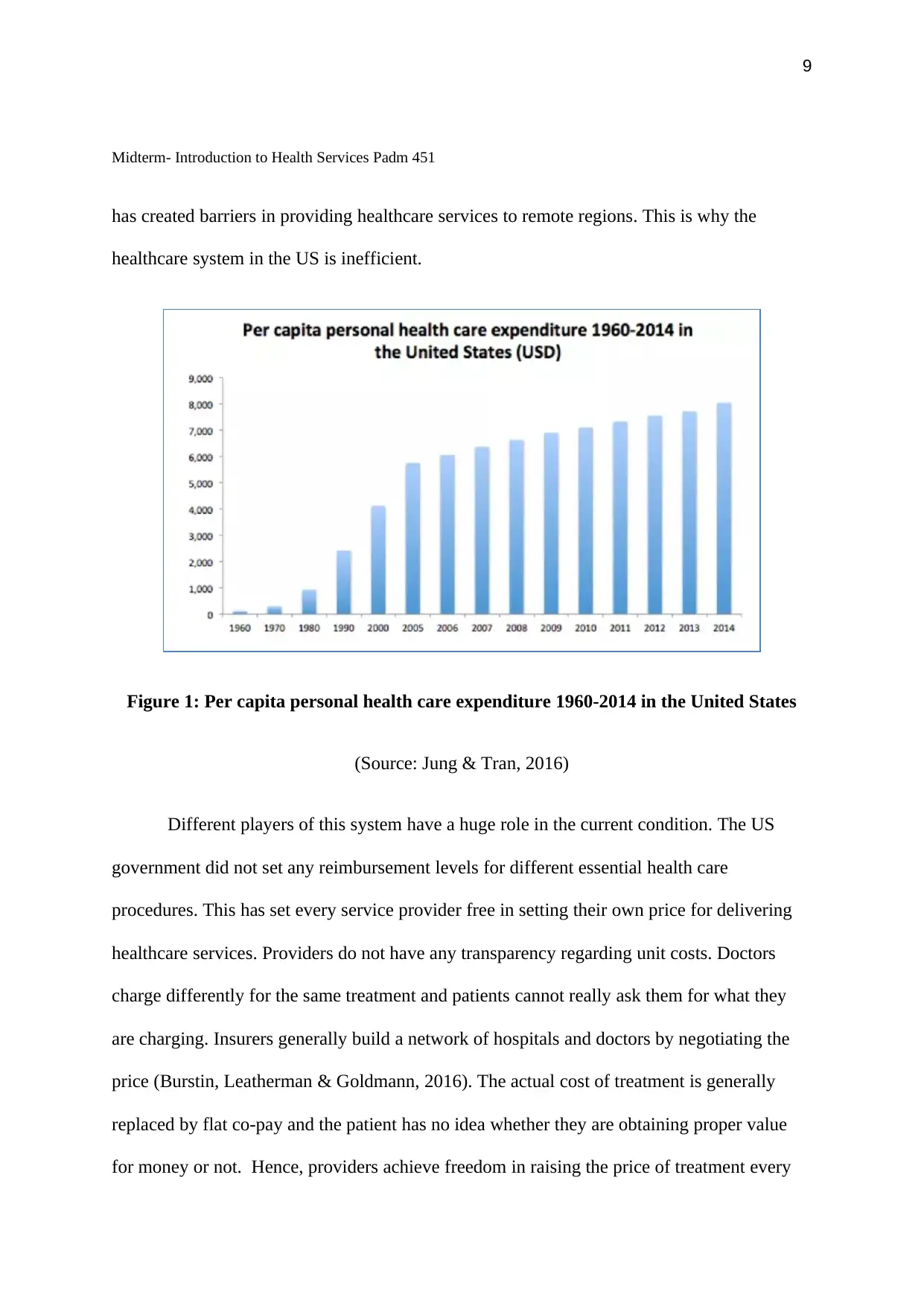
9
Midterm- Introduction to Health Services Padm 451
has created barriers in providing healthcare services to remote regions. This is why the
healthcare system in the US is inefficient.
Figure 1: Per capita personal health care expenditure 1960-2014 in the United States
(Source: Jung & Tran, 2016)
Different players of this system have a huge role in the current condition. The US
government did not set any reimbursement levels for different essential health care
procedures. This has set every service provider free in setting their own price for delivering
healthcare services. Providers do not have any transparency regarding unit costs. Doctors
charge differently for the same treatment and patients cannot really ask them for what they
are charging. Insurers generally build a network of hospitals and doctors by negotiating the
price (Burstin, Leatherman & Goldmann, 2016). The actual cost of treatment is generally
replaced by flat co-pay and the patient has no idea whether they are obtaining proper value
for money or not. Hence, providers achieve freedom in raising the price of treatment every
Midterm- Introduction to Health Services Padm 451
has created barriers in providing healthcare services to remote regions. This is why the
healthcare system in the US is inefficient.
Figure 1: Per capita personal health care expenditure 1960-2014 in the United States
(Source: Jung & Tran, 2016)
Different players of this system have a huge role in the current condition. The US
government did not set any reimbursement levels for different essential health care
procedures. This has set every service provider free in setting their own price for delivering
healthcare services. Providers do not have any transparency regarding unit costs. Doctors
charge differently for the same treatment and patients cannot really ask them for what they
are charging. Insurers generally build a network of hospitals and doctors by negotiating the
price (Burstin, Leatherman & Goldmann, 2016). The actual cost of treatment is generally
replaced by flat co-pay and the patient has no idea whether they are obtaining proper value
for money or not. Hence, providers achieve freedom in raising the price of treatment every
⊘ This is a preview!⊘
Do you want full access?
Subscribe today to unlock all pages.

Trusted by 1+ million students worldwide
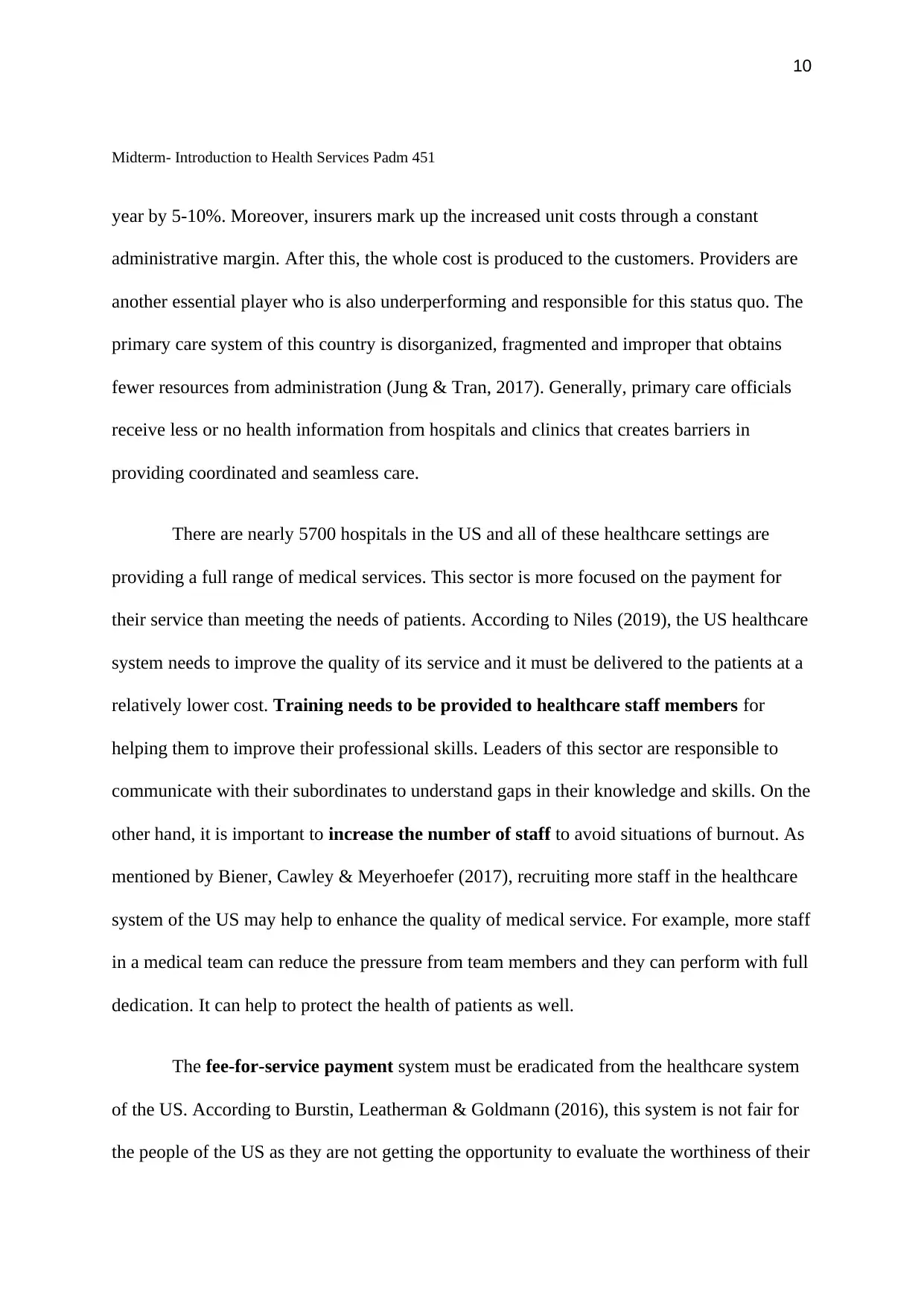
10
Midterm- Introduction to Health Services Padm 451
year by 5-10%. Moreover, insurers mark up the increased unit costs through a constant
administrative margin. After this, the whole cost is produced to the customers. Providers are
another essential player who is also underperforming and responsible for this status quo. The
primary care system of this country is disorganized, fragmented and improper that obtains
fewer resources from administration (Jung & Tran, 2017). Generally, primary care officials
receive less or no health information from hospitals and clinics that creates barriers in
providing coordinated and seamless care.
There are nearly 5700 hospitals in the US and all of these healthcare settings are
providing a full range of medical services. This sector is more focused on the payment for
their service than meeting the needs of patients. According to Niles (2019), the US healthcare
system needs to improve the quality of its service and it must be delivered to the patients at a
relatively lower cost. Training needs to be provided to healthcare staff members for
helping them to improve their professional skills. Leaders of this sector are responsible to
communicate with their subordinates to understand gaps in their knowledge and skills. On the
other hand, it is important to increase the number of staff to avoid situations of burnout. As
mentioned by Biener, Cawley & Meyerhoefer (2017), recruiting more staff in the healthcare
system of the US may help to enhance the quality of medical service. For example, more staff
in a medical team can reduce the pressure from team members and they can perform with full
dedication. It can help to protect the health of patients as well.
The fee-for-service payment system must be eradicated from the healthcare system
of the US. According to Burstin, Leatherman & Goldmann (2016), this system is not fair for
the people of the US as they are not getting the opportunity to evaluate the worthiness of their
Midterm- Introduction to Health Services Padm 451
year by 5-10%. Moreover, insurers mark up the increased unit costs through a constant
administrative margin. After this, the whole cost is produced to the customers. Providers are
another essential player who is also underperforming and responsible for this status quo. The
primary care system of this country is disorganized, fragmented and improper that obtains
fewer resources from administration (Jung & Tran, 2017). Generally, primary care officials
receive less or no health information from hospitals and clinics that creates barriers in
providing coordinated and seamless care.
There are nearly 5700 hospitals in the US and all of these healthcare settings are
providing a full range of medical services. This sector is more focused on the payment for
their service than meeting the needs of patients. According to Niles (2019), the US healthcare
system needs to improve the quality of its service and it must be delivered to the patients at a
relatively lower cost. Training needs to be provided to healthcare staff members for
helping them to improve their professional skills. Leaders of this sector are responsible to
communicate with their subordinates to understand gaps in their knowledge and skills. On the
other hand, it is important to increase the number of staff to avoid situations of burnout. As
mentioned by Biener, Cawley & Meyerhoefer (2017), recruiting more staff in the healthcare
system of the US may help to enhance the quality of medical service. For example, more staff
in a medical team can reduce the pressure from team members and they can perform with full
dedication. It can help to protect the health of patients as well.
The fee-for-service payment system must be eradicated from the healthcare system
of the US. According to Burstin, Leatherman & Goldmann (2016), this system is not fair for
the people of the US as they are not getting the opportunity to evaluate the worthiness of their
Paraphrase This Document
Need a fresh take? Get an instant paraphrase of this document with our AI Paraphraser
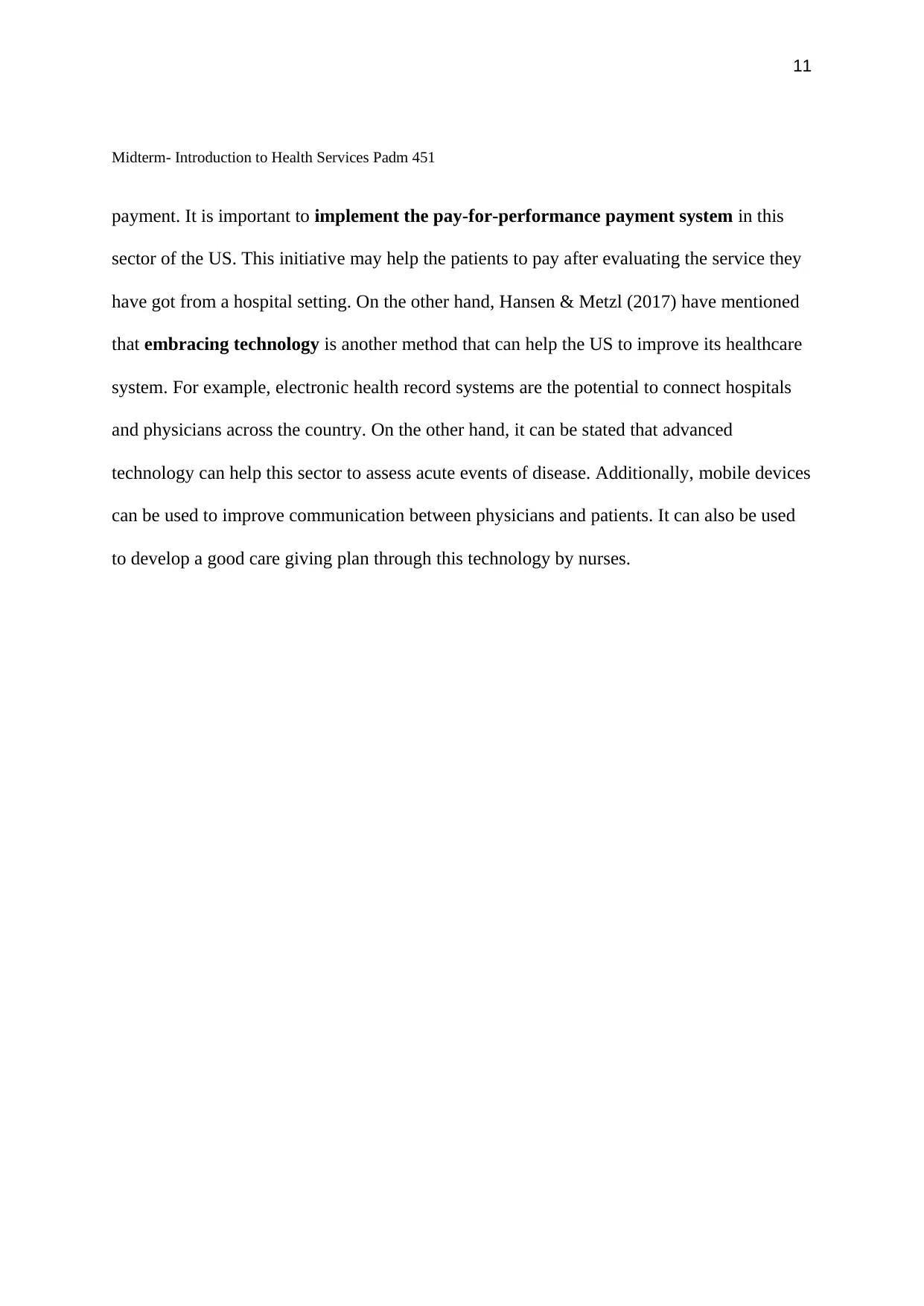
11
Midterm- Introduction to Health Services Padm 451
payment. It is important to implement the pay-for-performance payment system in this
sector of the US. This initiative may help the patients to pay after evaluating the service they
have got from a hospital setting. On the other hand, Hansen & Metzl (2017) have mentioned
that embracing technology is another method that can help the US to improve its healthcare
system. For example, electronic health record systems are the potential to connect hospitals
and physicians across the country. On the other hand, it can be stated that advanced
technology can help this sector to assess acute events of disease. Additionally, mobile devices
can be used to improve communication between physicians and patients. It can also be used
to develop a good care giving plan through this technology by nurses.
Midterm- Introduction to Health Services Padm 451
payment. It is important to implement the pay-for-performance payment system in this
sector of the US. This initiative may help the patients to pay after evaluating the service they
have got from a hospital setting. On the other hand, Hansen & Metzl (2017) have mentioned
that embracing technology is another method that can help the US to improve its healthcare
system. For example, electronic health record systems are the potential to connect hospitals
and physicians across the country. On the other hand, it can be stated that advanced
technology can help this sector to assess acute events of disease. Additionally, mobile devices
can be used to improve communication between physicians and patients. It can also be used
to develop a good care giving plan through this technology by nurses.
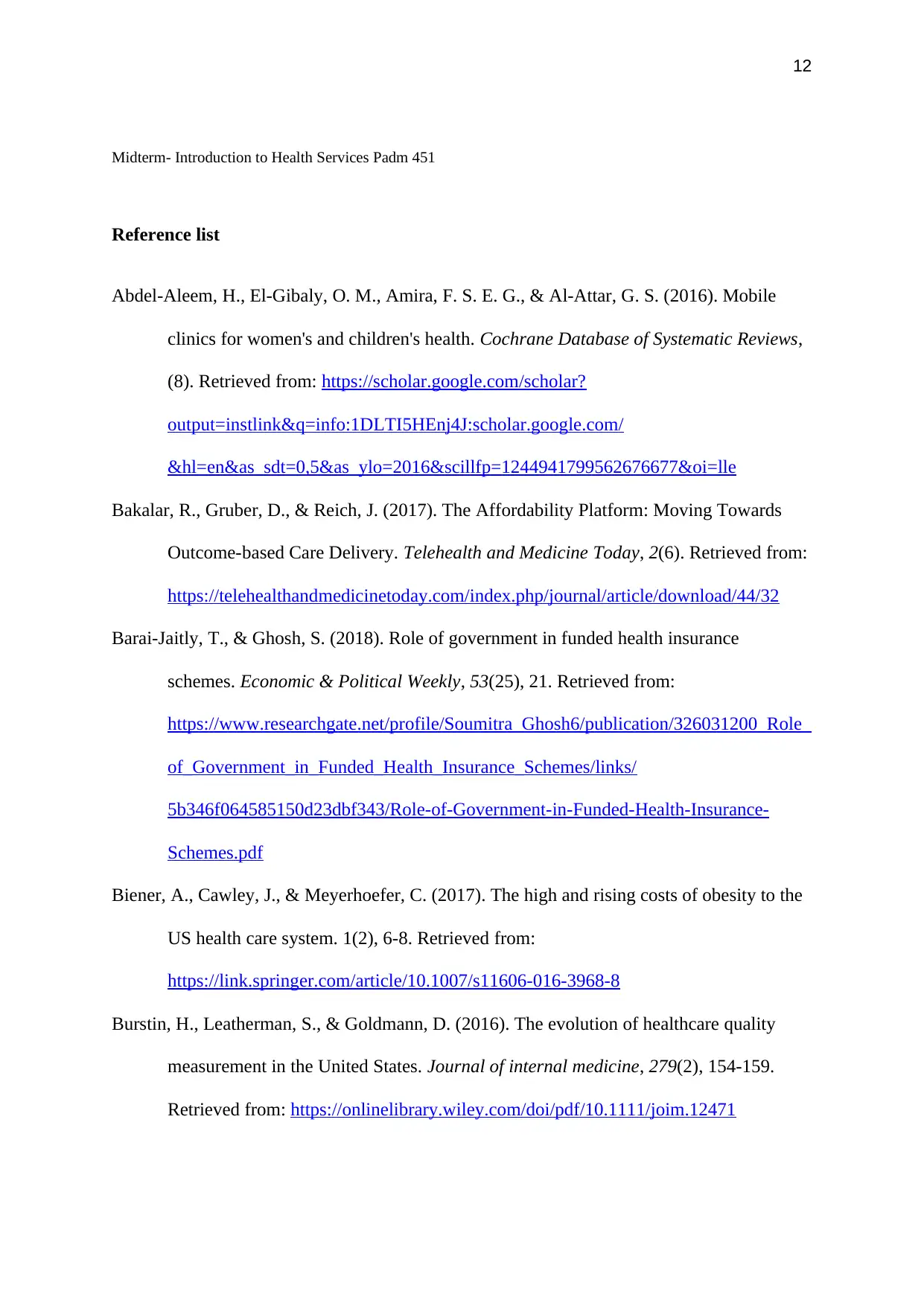
12
Midterm- Introduction to Health Services Padm 451
Reference list
Abdel‐Aleem, H., El‐Gibaly, O. M., Amira, F. S. E. G., & Al‐Attar, G. S. (2016). Mobile
clinics for women's and children's health. Cochrane Database of Systematic Reviews,
(8). Retrieved from: https://scholar.google.com/scholar?
output=instlink&q=info:1DLTI5HEnj4J:scholar.google.com/
&hl=en&as_sdt=0,5&as_ylo=2016&scillfp=1244941799562676677&oi=lle
Bakalar, R., Gruber, D., & Reich, J. (2017). The Affordability Platform: Moving Towards
Outcome-based Care Delivery. Telehealth and Medicine Today, 2(6). Retrieved from:
https://telehealthandmedicinetoday.com/index.php/journal/article/download/44/32
Barai-Jaitly, T., & Ghosh, S. (2018). Role of government in funded health insurance
schemes. Economic & Political Weekly, 53(25), 21. Retrieved from:
https://www.researchgate.net/profile/Soumitra_Ghosh6/publication/326031200_Role_
of_Government_in_Funded_Health_Insurance_Schemes/links/
5b346f064585150d23dbf343/Role-of-Government-in-Funded-Health-Insurance-
Schemes.pdf
Biener, A., Cawley, J., & Meyerhoefer, C. (2017). The high and rising costs of obesity to the
US health care system. 1(2), 6-8. Retrieved from:
https://link.springer.com/article/10.1007/s11606-016-3968-8
Burstin, H., Leatherman, S., & Goldmann, D. (2016). The evolution of healthcare quality
measurement in the United States. Journal of internal medicine, 279(2), 154-159.
Retrieved from: https://onlinelibrary.wiley.com/doi/pdf/10.1111/joim.12471
Midterm- Introduction to Health Services Padm 451
Reference list
Abdel‐Aleem, H., El‐Gibaly, O. M., Amira, F. S. E. G., & Al‐Attar, G. S. (2016). Mobile
clinics for women's and children's health. Cochrane Database of Systematic Reviews,
(8). Retrieved from: https://scholar.google.com/scholar?
output=instlink&q=info:1DLTI5HEnj4J:scholar.google.com/
&hl=en&as_sdt=0,5&as_ylo=2016&scillfp=1244941799562676677&oi=lle
Bakalar, R., Gruber, D., & Reich, J. (2017). The Affordability Platform: Moving Towards
Outcome-based Care Delivery. Telehealth and Medicine Today, 2(6). Retrieved from:
https://telehealthandmedicinetoday.com/index.php/journal/article/download/44/32
Barai-Jaitly, T., & Ghosh, S. (2018). Role of government in funded health insurance
schemes. Economic & Political Weekly, 53(25), 21. Retrieved from:
https://www.researchgate.net/profile/Soumitra_Ghosh6/publication/326031200_Role_
of_Government_in_Funded_Health_Insurance_Schemes/links/
5b346f064585150d23dbf343/Role-of-Government-in-Funded-Health-Insurance-
Schemes.pdf
Biener, A., Cawley, J., & Meyerhoefer, C. (2017). The high and rising costs of obesity to the
US health care system. 1(2), 6-8. Retrieved from:
https://link.springer.com/article/10.1007/s11606-016-3968-8
Burstin, H., Leatherman, S., & Goldmann, D. (2016). The evolution of healthcare quality
measurement in the United States. Journal of internal medicine, 279(2), 154-159.
Retrieved from: https://onlinelibrary.wiley.com/doi/pdf/10.1111/joim.12471
⊘ This is a preview!⊘
Do you want full access?
Subscribe today to unlock all pages.

Trusted by 1+ million students worldwide
1 out of 14
Related Documents
Your All-in-One AI-Powered Toolkit for Academic Success.
+13062052269
info@desklib.com
Available 24*7 on WhatsApp / Email
![[object Object]](/_next/static/media/star-bottom.7253800d.svg)
Unlock your academic potential
Copyright © 2020–2025 A2Z Services. All Rights Reserved. Developed and managed by ZUCOL.





